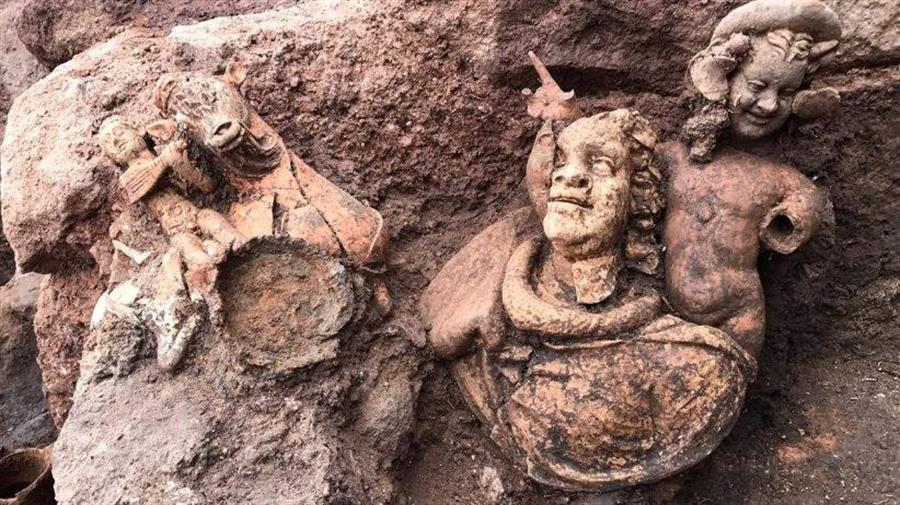
Archaeological excavations that have been carried out in the 2,300-year-old Kurul Castle in the Black Sea province of Ordu have unearthed the 2,100-year-old the Kybele Statue, as well as three other big statues and other 2,000 historical artifacts. While excavations still continue on the top of the castle, which is a first degree archaeological and natural site, dynamites are used for a quarry in the lower side.
Historical rock tombs and caves have been destroyed because of the dynamite explosions despite the Samsun Council of Monuments’ report that “it is not appropriate to open an andesite quarry in the area,” and the Council of State’s decision to cancel the establishment of the quarry.
Excavations were initiated in 2010 at the 2,300-year-old Kurul Castle, dating back to the 6th Mithridates period and located within the borders of the Bayadı neighborhood in Altınordu district.
Under the leadership of Ordu Museum Directorate, a team of 40 people including Gazi University faculty member Professor Yücel Şenyurt and 25 archaeologists have found the Mother Goddess Kybele statue, three other big sculptures and some 2,000 pieces of historical artifacts.
Also during the excavations in the castle, which is a first degree archaeological and natural site, an approximately 300-step staircase, terracotta roof tiles and masonry ceramic pieces, which are considered to belong to the periods before Christ, were also unearthed.
While an application was made for the castle to be included in the UNESCO World Heritage Tentative List, the archaeological excavations were suspended during to the winter period.
Among the most important historical artifacts found in the castle were the statue of the 200-kg Mother Goddess Kybele statue, which dates back 2,100 years, the god of fertility Dionyss, Pan statue and a Rhyton, which is an animal-shaped religious container. The 110-centimeter Kybele sculpture was the first marble sculpture in Turkey to be discovered in its original place.
Enis Ayar, a tourism activist living in the city, said that the historical texture in the area has been destroyed. Asking quarry activities to be stopped, Ayar said nature was being “slaughtered”.
“This is a murder; archeological sites are exploited. There were rock tombs here. Now these rock tombs have been exploded with dynamite. The rock tombs here moved out of the archaeological after the excavation consultant, Professor Şenyurt, as the chairman of the scientific board, gave a report in line with the narrowing of the archaeological site and the expansion of the construction areas,” he said.
“Instead of protecting the property of the state, they act as if they are employees of the quarry company. This is why this murder should stop as soon as possible. There is an acropolis above and metropolis below. While there is excavation with brushes in the acropolis above, dynamite is exploded in the metropolis below. The historical texture is being destroyed. It is not possible to replace them again. It should be stopped as soon as possible.”
Several negativities
Geological Engineer Kübra Güvenç Bacınoğlu pointed out that many historical artifacts can be unearthed from the castle, adding, “In every dynamite explosion, our house shakes like there is an earthquake. At least 15 historic tombs here were destroyed due to the dynamite explosions. There are caves here.”
“We previously entered the caves with professors from the university. We worked to include these caves in the protected archaeological area, but most of those caves were destroyed. Because the layer structure collapsed every time dynamite was exploded, all the people in this area lost their water and their houses received damage. There are lots of negativities here. A Kybele statue was found here as well as many other 2,100-year-old statuettes. And there are many historical artifacts that can be unearthed here. First of all this is a settlement where people live,” she added.
About the claims that he gave permission for the stone quarry in the area, Şenyurt stated that he did not give the permission, adding, “The location of the quarry has never been an archaeological site. The Samsun Council of Monuments said that the stone quarry will give damage to the area in its report but the company won the court case. This quarry is about 900 meters from the area where are working. Until now, we have not seen the damage of the exploded dynamite. But we feel small earthquakes when the dynamites are exploded. Who would want the quarry there? Who wants an image that disturbs the nature there? If only the courts hadn’t given permission for it.”
Stating that he is not authorized to close the quarry, Şenyurt said, “I did not give permission for this quarry. I have no such authority. I asked people to open a signature campaign against the quarry and I will give the first signature. But they say I have the authority, I can close it. But I don’t.”